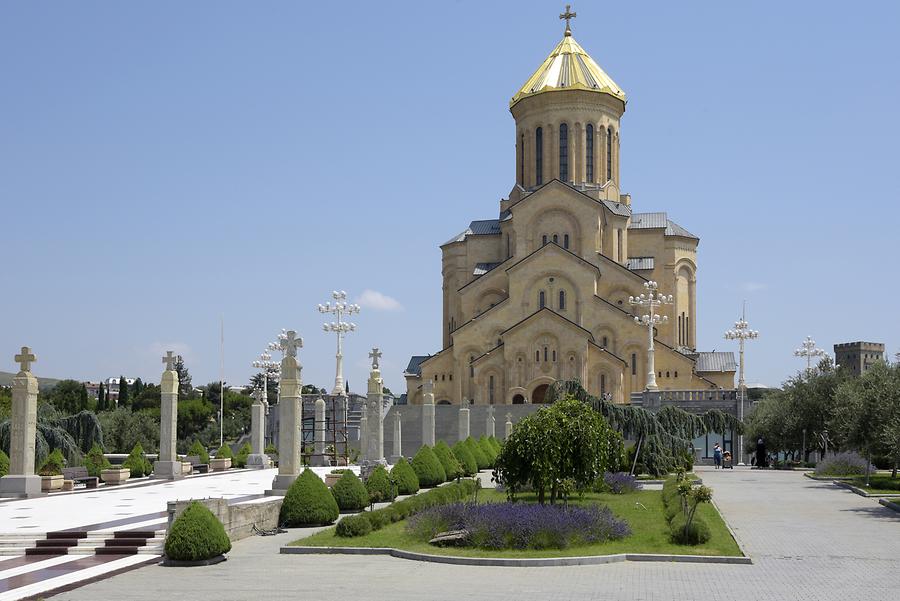Holy Trinity Cathedral of Tbilisi#

Holy Trinity Cathedral of Tbilisi, July 2018, © Gerhard Huber, under CC BY-NC 4.0 +Edu
Unübersehbar sticht die Kathedrale von Tiflis seit 2004 aus dem Stadtbild, eine der größten orthodoxen Kirchen überhaupt, finanziert von einem georgischen Unternehmer. 84 m hoch ragt der Bau in den Himmel. Er fasst 15.000 Gläubige. Seit dem 5. Jahrhundert ist Georgien christlich geprägt. Heute bekennen sich 84 % zur orthodoxen Lehre. Wer das Land verstehen möchte, muss daher einen kleinen Ausflug in die Welt des georgischen Glaubens unternehmen:
Die orthodoxe, d.h. rechtgläubige Kirche demonstriert schon mit ihrem Namen den Anspruch, einzig rechtmäßige Nachfolgerin der römischen Kirche zu sein. Entstanden ist sie 1054 beim großen morgenländischen Schisma. Damals spalteten machtpolitische Überlegungen die christliche Kirche in einen westlichen Teil unter Herrschaft des Papstes in Rom und einen östlichen Teil mit dem Patriarchen von Konstantinopel an der Spitze.
Heute existieren weltweit 13 orthodoxe Kirchen, die unabhängig voneinander von einem eigenen Oberhaupt, einem Erzbischof oder Patriarchen regiert werden. Im Falle der georgisch-orthodoxen Kirche ist es der Patriarch und Erzbischof der Sameba-Kathedrale von Tiflis. Er wird als direkter Nachfolger der Apostel gesehen.
Wie alle orthodoxen Glaubensrichtungen zeichnet sich auch die georgische durch ihre aufwändigen Gottesdienste aus. Im Mittelpunkt steht eine reiche, hauptsächlich gesungene Liturgie voller Symbolik. Im Unterschied zu katholischen Geistlichen sind die orthodoxen Priester verheiratet. Nur Bischöfe und Mönche bleiben dem Zölibat verpflichtet.
Kirche und Staat sind in Georgien nicht streng getrennt, sondern pflegen eine sogenannte harmonische Beziehung. Der Patriarch segnet das Parlament vor jeder Legislaturperiode. Zudem genießt die georgische Kirche Verfassungsrang und Steuerfreiheit. Sie darf sich über großzügige finanzielle Zuschüsse freuen.
The Cathedral of Tbilisi stands out from the cityscape since 2004. It is one of the largest orthodox churches existing, financed by a Georgian entrepreneur. It is 84 meters high and holds 15,000 believers. Georgia has been Christian since the 5th century. Today 84% profess orthodox doctrine. So, if you want to understand the country, you have to take a little trip into the world of Georgian faith: the orthodox church already demonstrates with its name the claim to be the only legitimate successor of the Roman church. It was created in 1054 at the great Oriental schism. Back then, power-political considerations split the Christian Church into a western part under papal rule in Rome and an eastern part headed by the Patriarch of Constantinople. Today, 13 Orthodox churches exist worldwide, governed independently by their own chief, an archbishop or patriarch. In the case of the Georgian Orthodox Church, it is the Patriarch and Archbishop of the Sameba Cathedral of Tbilisi. He is seen as the direct successor of the apostles. Like all orthodox faiths, the Georgian people are characterized by their elaborate worship services. The focus is on a rich, mainly sung liturgy full of symbolism. Unlike Catholic clergy, Orthodox priests are married. Only bishops and monks remain committed to celibacy. Church and state are not strictly separated in Georgia, but maintain a so-called harmonious relationship. The patriarch blesses the parliament before each legislature. In addition, the Georgian Church enjoys constitutional status and tax exemption. It can look forward to generous financial grants.